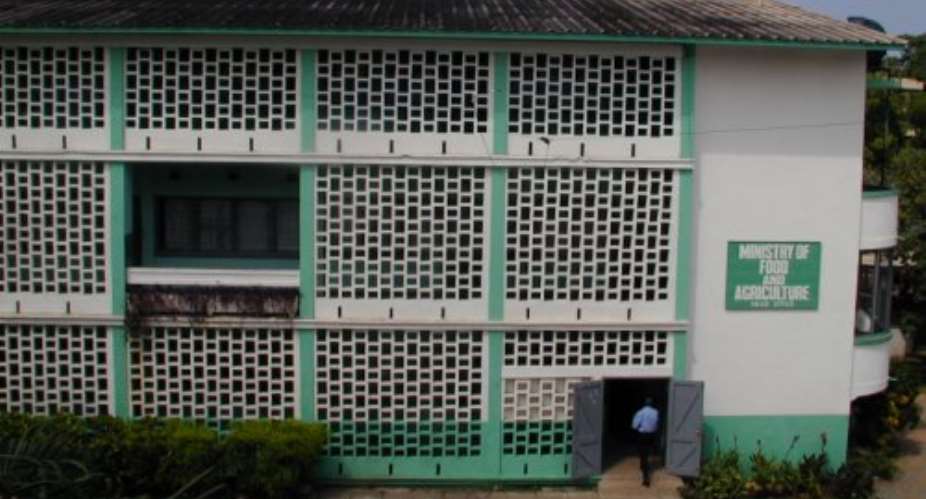GHANA may suffer an aggregate food shortage of 400,000 metric tonnes this year due to irregular rainfall pattern in the southern part of the country.
The Ministry of Food and Agriculture said the shortage would affect some selected crops, especially maize.
This year the government imported about 600,000 metric tonnes of white maize and 70,000 bags of yellow maize to make up for the expected domestic shortfalls.
Other food items to be affected by low production this year include yam, cassava, rice, plantain, cocoyam and other roots and tuber crops.
According to the Ministry, this year's rainfall pattern has deviated from the norm and in the southern sector which depended on rain - fed agriculture, the rains delayed for six weeks, causing most fields to be planted late.
Last year Ghana recorded 1,158,000 metric tonnes of maize which, according to the ministry, exceeded the annual projection.
Mr Emmanuel Aggrey-Fynn, Director of Statistics, Research and Information of the Ministry told the Graphic yesterday that this year, it would be difficult for the country to achieve last year's production levels if the rains stopped in July as had been the pattern.
In that event, he said, cereals such as maize would suffer severely.
Cassava, plantain, yam and other roots and tubers, he noted, would also suffer a decline over last year's production.
He said cassava last year recorded a yield of nine million metric tonnes which was about 30 per cent above the domestic requirement while plantain was 2.4 million metric tonnes.
He contrasted that with rice production, saying that at 145,000 metric tonnes annually, Ghana has been producing only 40 per cent of domestic requirements.
Mr Aggrey-Fynn said if the rainfall continued to August and beyond, the country could expect agricultural production levels to be similar to those of 2004.
He said despite efforts by the agriculture ministry to increase agricultural production to meet the needs of the growing population the annual growth rate for areas planted with food crops had not appreciated significantly since 1998.
The Director explained that from 1998 - 2000, 643,400 hectares had been put under cassava cultivation and 596,100 hectares were for maize production.
Mr Aggrey-Fynn said a slight increase was recorded from 2001-2003 when cassava was put under 776,000 hectares and maize 814,900 hectares.
He said the Ministry Of Food and Agriculture had developed a facility to assist farmers to increase their acreage and put more land under cultivation in the lean crop season to offset the low production levels expected to be recorded





 Avoid pre-registered SIMs, buyer and seller liable for prosecution – Ursula Owus...
Avoid pre-registered SIMs, buyer and seller liable for prosecution – Ursula Owus...
 Election 2024: Mahama has nothing new to offer Ghanaians, Bawumia is the future ...
Election 2024: Mahama has nothing new to offer Ghanaians, Bawumia is the future ...
 OSP files fresh charges against ex- PPA Boss
OSP files fresh charges against ex- PPA Boss
 Withdraw unreasonable GH¢5.8m fine against former board members – ECG tells PURC
Withdraw unreasonable GH¢5.8m fine against former board members – ECG tells PURC
 Akroma mine attack: Over 20 armed robbers injure workers, steal gold at Esaase
Akroma mine attack: Over 20 armed robbers injure workers, steal gold at Esaase
 Those who understand me have embraced hope for the future — Cheddar
Those who understand me have embraced hope for the future — Cheddar
 Ghana will make maiden voyage into space should Bawumia become President — Chair...
Ghana will make maiden voyage into space should Bawumia become President — Chair...
 Train crash: Despite the sabotage, we shall not be deterred and will persevere —...
Train crash: Despite the sabotage, we shall not be deterred and will persevere —...
 Tema-Mpakadan railway project a perversion of the original viable concept design...
Tema-Mpakadan railway project a perversion of the original viable concept design...
 Train crash: Elsewhere, everyone involved in the test will either be fired or re...
Train crash: Elsewhere, everyone involved in the test will either be fired or re...
